
Shipping Container Design
How It Works?

Step 1
Send us the architectural floor plans.

Step 2
Our experts will analyze the documents uploaded by you to design MEP plans

Step 3
We send you an optimized MEP plans within 2 weeks per floor.
Get In Touch
Need help or additional information?
Give us a call on
(786) 788-0295
Get in touch - 212-575-5300
Shipping Container Design Starting From
- Fastest turnaround of 2 weeks
- Design based on IBC standerds
- Faster designs based on modular ideas
- All trades covered and coordinated
- Clash free MEP design as per local laws
Shipping Container Design
Sustainable Approach
We deliver design to encourage fast-to-build process
VE Approach
Our designs are definitely cost driven which increases Contractor adaptability
IBC Compliance
Our design adhere to International Building Code and can ease permit filings.
What is a Shipping Container Home?
A shipping container home is an innovative way of crafting functional living spaces using recycled cargo containers. These homes are environmentally friendly, cost-effective, and remarkably versatile, allowing for unique and customizable designs. With their sturdy structure and modern aesthetic, shipping container homes are becoming a popular choice for eco-conscious individuals and design enthusiasts.
From basic storage to aesthetic, fully-functional, architectural designs
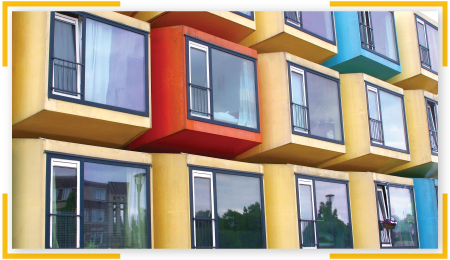
Robust steel shipping containers were invented and developed for transportation of cargo in the mid-1950s. Little more than three decades later, the first U.S. patent for converting shipping containers into habitable buildings was filed successfully.
Today recycled shipping containers are used in many parts of the world, including the Netherlands, U.S., United Kingdom, France, Israel, and South Africa. Furthermore, they are used for many different purposes including mobile site offices, housing, getaway retreats, shops, restaurants, coffee shops, pubs, conference and training rooms, booths for parking attendants, and clinics, schools, and even for standalone ablution facilities and innovative gym units. They are also commonly used for storage of just about any kind, including household goods; and many companies hire containers that are stored in fairly large numbers within secure locations.
Even though they are manufactured in only three standard sizes, shipping containers are incredibly versatile and they are made to strict international standards. Undeniably the strongest boxes in the world, multiple units can be combined in a myriad of ways. They can be used alongside one another or stacked to create multi-story structures. They can be reconfigured into larger spaces by removing one side of two containers to double their size. Or they can be used around an area that has a common roof structure that covers the containers as well as a central or adjacent space.
But steel shipping containers are really just an innovative building material. Other than shipping cargo and storing all kinds of stuff, from raw materials to treasured possessions, they need to be substantially modified if they are going to be used for human habitation of any kind. Doors and windows need to be fitted, and plumbing and electrics installed. All the elements of heating, ventilation, and air-conditioning (HVAC) need to be considered and incorporated into a well thought out design. Depending on the function converted shipping containers will fulfill, a comprehensive fire protection system may also need to be incorporated into the design.
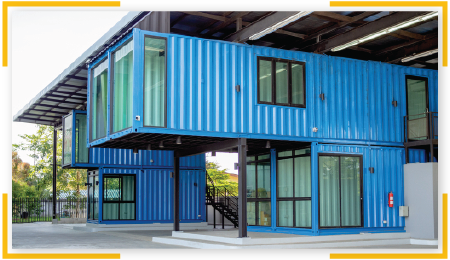
While container conversion, originally proposed as a highly economic form of construction, is generally cost-effective and a lot quicker and less labor-intensive to complete than traditional brick-and-mortar or timber structures, human-centric structures demand the same technologies as traditional construction to make them suitable for purpose.
Used for emergency shelter or as a traditional prefabricated building, perhaps as a structure assembled on-site to form a fundamental site office or even basic accommodation, a shipping container will be fitted with doors and windows and will incorporate some sort of insulation. But the mechanical, electrical, and plumbing systems will normally be very basic and limited to running water and essential electrification. When container conversions are designed for housing and other more permanent functions, there is a vital need for input by mechanical, electrical, and plumbing (MEP) engineering professionals because the requirements are considerably more sophisticated.
By working closely with engineers who have the experience and capabilities to ensure that MEP systems meet local building codes and regulations, architects can create stylish, eco-friendly homes, offices, and other buildings that are both sustainable and aesthetically appealing.
Shipping Container Design
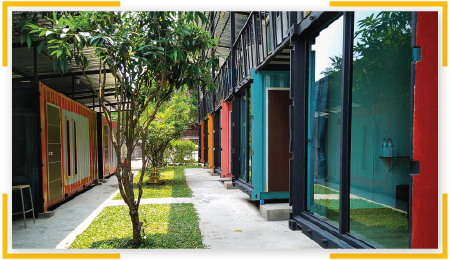
Developed by an American trucker, Malcolm McLean, who had one of the largest truck transportation business in the U.S. in the 1940s and 50s, shipping containers revolutionized the international transport industry.
While McLean’s original containers were standardized in terms of size (all 35-foot), extremely strong, stackable, and lockable, they were relatively rudimentary. But the industry developed fast, and in 1968 the first International Organization for Standardization (ISO) standards were introduced. These defined the terminology, dimensions, and ratings of freight containers as well as the way they should be identified.
As a result of these original standards, sizes for shipping containers were regulated. All general-purpose (GP) containers have a width of just under 2.5 m or 8 ft:
- 20 foot (6 m) containers that measure 20 ft x 8 ft (6.058 m x 2.438 m) and are 8.5 ft (2.591 m) high. These are also available as high cubes that are 9.5 ft (2.896 m) high.
- 40-foot (12 m) containers that measure 40 ft x 8 ft (12.192 m x 2.438 m) and are 8.5 ft (2.591 m) high. High cubes are also available.
- 10-foot (3 m) containers that measure 10 ft x 8 ft (2.991 m x 2.438 m) and are 8.5 ft (2.591 m) high
Today there are different types of containers designed for different purposes, including those intended for transporting dry freight across the oceans, and reefers that are designed for storing and transporting items that need to be refrigerated. There are also specialized shipping containers that are manufactured for the transportation of oversized or unconventional cargo. However, GP containers are the norm for architectural conversion products.
ISO 1496-1 : 1990 (E), Series 1 freight containers – Specification and testing – Part 1: General cargo containers for general purposes details how GP containers transported by sea, road, or rail should be manufactured. In addition to dimensions, the standards specify tolerances as well as specifications for every part of the container: corner fittings, the end and the side structures, the walls and door openings, and the corner fittings which are very important for easy stacking.
Other vital requirements relate to strength, loads and loadings, locking devices fitted for container roofs (or tops), as well as the securing systems that are suitable for doors. Weatherproof covers are also included in the specifications. The testing procedures used to ensure that freight containers have been correctly manufactured are included in the same ISO. They include tests for:
- stacking containers that are fully loaded
- lifting containers from the four corner fittings at the top of the box
- lifting containers from the four corner fittings at the bottom of the box
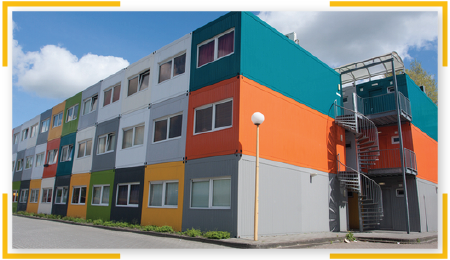
An additional 10 test procedures are provided. These enable manufacturers to test the strength of each part of the container – the end and side walls, the floor, and the roof – as well as its longitudinal restraint and transverse and longitudinal rigidity. There is also a test for checking whether it is weatherproof and for the efficiency of lifting it from fork-lift pockets and the base where grappler arms are positioned (if these are fitted).
While these standards were devised to ensure that shipping containers are strong and secure for transportation and storage before, during, and after transportation, they also provide peace of mind for those opting for a container conversion or construction project. When choosing used containers for new construction projects, it is important to assess their structural integrity, which is another role that an engineer might play. Old containers may be dented and rusted after being transported over the ocean. Also, they are sometimes coated with lead-based paints or other products to protect the metal surfaces from moisture and from salt in the seawater. These must be covered for safety reasons. However, it is common for architects to design container structures with new floors, ceilings, and walls, both internal and external. This effectively covers dings and dents and also provides an easy means to install essential insulation. That said, it is not unusual for new shipping containers to be specified for projects.
While basic plumbing and power are relatively easy to install, heating and cooling systems often present a major challenge in this environment, which is why an increasing number of architects like to team up with MEP engineers for container construction projects. Another factor is that even though containers themselves are manufactured in accordance with strict international (ISO) standards, there are also codes and regulations that must be followed when containers are converted for alternative use. These usually depend on local regulations that vary from area to area, city to city, and even country to country. Some places may not even have regulations, which might translate to a lack of control or, on the other hand, to a blanket prohibition. For instance, while codes for so-called pre-fab structures might not be strict, in many places the regulations relating to container construction could be stringent because this type of construction is largely untested.
It is essential to ascertain ground rules before going ahead with shipping container construction.
Pros and Cons of Shipping Containers Home Design
Pros:
- Cost-Effective: Shipping containers are relatively inexpensive compared to traditional building materials, making them an affordable option for housing.
- Durability: Built to withstand harsh oceanic conditions, shipping containers are incredibly strong and durable.
- Eco-Friendly: Reusing shipping containers reduces waste and promotes sustainable building practices.
- Quick Construction: Modular nature allows for faster construction and reduced labor costs.
- Customizable: Shipping containers can be easily modified and personalized to fit various design preferences.
Cons:
- Insulation: Shipping containers require additional insulation to be livable, especially in extreme climates.
- Space Constraints: Limited by the container's size, which may require creative design solutions for more spacious living areas.
- Permitting and Zoning: Building codes and zoning regulations can vary widely and may pose challenges.
- Corrosion: Containers are susceptible to rust if not properly maintained and treated.
What Would an Engineer Need to Know Before Designing with Shipping Containers?
Designing with shipping containers involves unique challenges that require thorough planning, particularly from an MEP (Mechanical, Electrical, Plumbing) perspective. Here’s what an MEP Engineer should consider:
- Structural Integrity: Understanding the structural limits of shipping containers and ensuring modifications do not compromise stability.
- Insulation and Ventilation: Proper insulation and ventilation systems are crucial to maintain comfortable temperatures and air quality.
- Electrical Systems: Efficient electrical design is essential for safety and functionality; ensure compliance with local electrical codes.
- Plumbing: Implementing effective plumbing systems within the confined space of a container requires innovative MEP design services.
- HVAC: Design and install heating, ventilation, and air conditioning systems to accommodate the unique spatial constraints.
Uses of Shipping Containers in Construction Sites
Shipping containers have found versatile applications in construction sites, offering practical solutions for various needs:
- Temporary Offices: Shipping containers can be quickly converted into on-site offices, providing a secure and comfortable workspace for project managers and engineers.
- Storage Units: Durable and weather-resistant, containers are perfect for storing tools, equipment, and materials safely on-site.
- Worker Accommodation: Shipping containers can be equipped as temporary living quarters for construction workers, ensuring comfort and safety.
- Portable Restrooms: Easily converted into sanitation units, shipping containers offer a hygienic solution for on-site restrooms.
- Break Rooms: Providing a space for workers to rest and recharge, containers can be outfitted with amenities like seating, kitchens, and showers.
By leveraging the adaptability and strength of shipping containers, construction companies can enhance efficiency and sustainability on their sites. Whether as homes or temporary structures, the potential of shipping containers is vast and promising. Start exploring the possibilities with our expert MEP design services today!
MEP Challenges for Container Structures
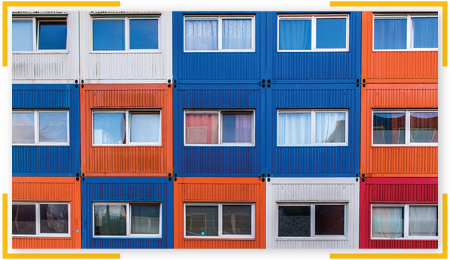
The MEP systems of any container structure are vitally important, as is the insulation that is incorporated in the design of the structure. The challenges in terms of spatial limitations are much greater than they could ever be for a traditional brick or timber dwelling.
Consider the many pipes, cables, vents and so on that are required. These cannot be incorporated unless there is cladding at very least inside the building where the insulation and various components can be positioned.
For this reason, designers commonly include a non-loadbearing frame around the inside perimeter of the container which can be used both to hang either gypsum board or another type of drywall material. The MEP system components can then be hidden within the gap, which is done once the framework is complete. Windows and doors are also cut at this early stage.
Ventilation, cooling, and heating, which an MEP engineer will also oversee, is another major challenge, largely due to the low height of containers. Generally, standard ventilation systems can be incorporated if shallow ductwork can be concealed in a ceiling that is slightly suspended. Radiant heating and cooling systems need less space because they utilize hoses rather than metal ducts.
Rather than come face-to-face with major challenges at the installation phase, architects can reduce potential problems by teaming up with an MEP firm at the outset. It is usually worth every dollar spent.



